2018 DODGE CHARGER overheating
[x] Cancel search: overheatingPage 91 of 553
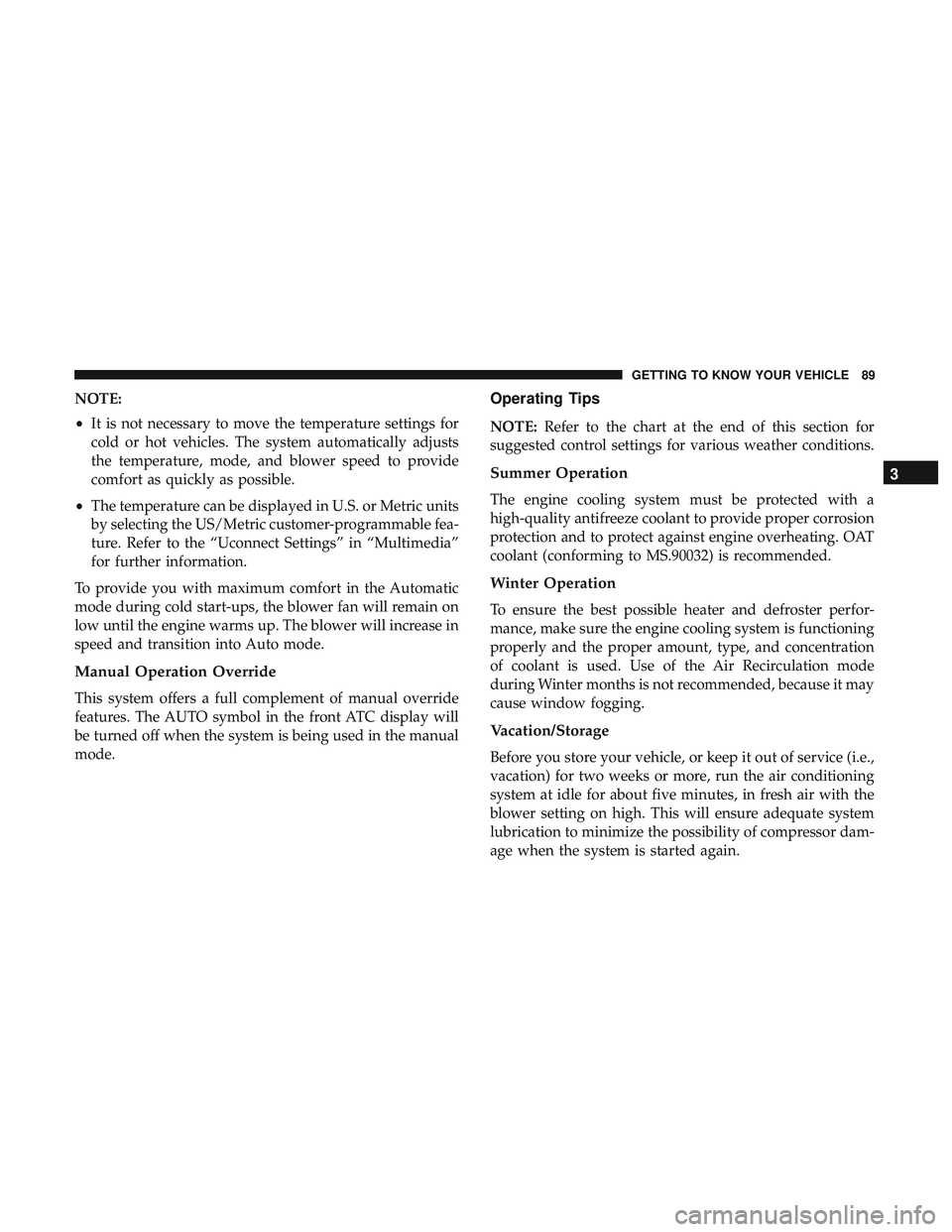
NOTE:
•It is not necessary to move the temperature settings for
cold or hot vehicles. The system automatically adjusts
the temperature, mode, and blower speed to provide
comfort as quickly as possible.
• The temperature can be displayed in U.S. or Metric units
by selecting the US/Metric customer-programmable fea-
ture. Refer to the “Uconnect Settings” in “Multimedia”
for further information.
To provide you with maximum comfort in the Automatic
mode during cold start-ups, the blower fan will remain on
low until the engine warms up. The blower will increase in
speed and transition into Auto mode.
Manual Operation Override
This system offers a full complement of manual override
features. The AUTO symbol in the front ATC display will
be turned off when the system is being used in the manual
mode.
Operating Tips
NOTE: Refer to the chart at the end of this section for
suggested control settings for various weather conditions.
Summer Operation
The engine cooling system must be protected with a
high-quality antifreeze coolant to provide proper corrosion
protection and to protect against engine overheating. OAT
coolant (conforming to MS.90032) is recommended.
Winter Operation
To ensure the best possible heater and defroster perfor-
mance, make sure the engine cooling system is functioning
properly and the proper amount, type, and concentration
of coolant is used. Use of the Air Recirculation mode
during Winter months is not recommended, because it may
cause window fogging.
Vacation/Storage
Before you store your vehicle, or keep it out of service (i.e.,
vacation) for two weeks or more, run the air conditioning
system at idle for about five minutes, in fresh air with the
blower setting on high. This will ensure adequate system
lubrication to minimize the possibility of compressor dam-
age when the system is started again.
3
GETTING TO KNOW YOUR VEHICLE 89
Page 108 of 553
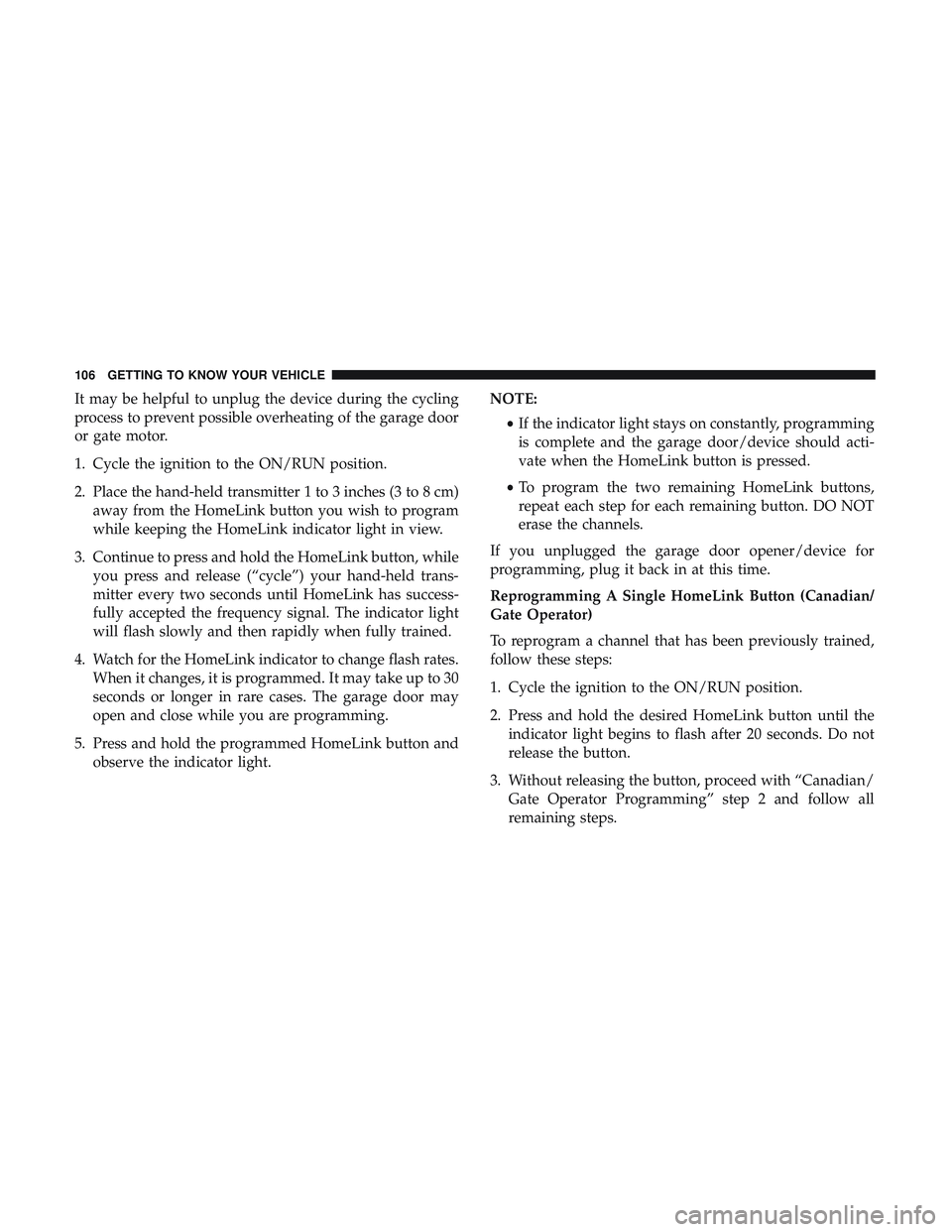
It may be helpful to unplug the device during the cycling
process to prevent possible overheating of the garage door
or gate motor.
1. Cycle the ignition to the ON/RUN position.
2. Place the hand-held transmitter 1 to 3 inches (3 to 8 cm)away from the HomeLink button you wish to program
while keeping the HomeLink indicator light in view.
3. Continue to press and hold the HomeLink button, while you press and release (“cycle”) your hand-held trans-
mitter every two seconds until HomeLink has success-
fully accepted the frequency signal. The indicator light
will flash slowly and then rapidly when fully trained.
4. Watch for the HomeLink indicator to change flash rates. When it changes, it is programmed. It may take up to 30
seconds or longer in rare cases. The garage door may
open and close while you are programming.
5. Press and hold the programmed HomeLink button and observe the indicator light. NOTE:
•If the indicator light stays on constantly, programming
is complete and the garage door/device should acti-
vate when the HomeLink button is pressed.
• To program the two remaining HomeLink buttons,
repeat each step for each remaining button. DO NOT
erase the channels.
If you unplugged the garage door opener/device for
programming, plug it back in at this time.
Reprogramming A Single HomeLink Button (Canadian/
Gate Operator)
To reprogram a channel that has been previously trained,
follow these steps:
1. Cycle the ignition to the ON/RUN position.
2. Press and hold the desired HomeLink button until the indicator light begins to flash after 20 seconds. Do not
release the button.
3. Without releasing the button, proceed with “Canadian/ Gate Operator Programming” step 2 and follow all
remaining steps.
106 GETTING TO KNOW YOUR VEHICLE
Page 344 of 553

If frequent jump starting is required to start your vehicle
you should have the battery and charging system in-
spected at an authorized dealer.
CAUTION!
Accessories plugged into the vehicle power outlets
draw power from the vehicle’s battery, even when not
in use (i.e., cellular devices, etc.). Eventually, if plugged
in long enough without engine operation, the vehicle’s
battery will discharge sufficiently to degrade battery
life and/or prevent the engine from starting.
IF YOUR ENGINE OVERHEATS
In any of the following situations, you can reduce the
potential for overheating by taking the appropriate action.
•On the highways — slow down.
• In city traffic — while stopped, place the transmission in
NEUTRAL, but do not increase the engine idle speed
while preventing vehicle motion with the brakes. NOTE:
There are steps that you can take to slow down an
impending overheat condition:
• If your air conditioner (A/C) is on, turn it off. The A/C
system adds heat to the engine cooling system and
turning the A/C off can help remove this heat.
• You can also turn the temperature control to maximum
heat, the mode control to floor and the blower control to
high. This allows the heater core to act as a supplement
to the radiator and aids in removing heat from the
engine cooling system.
WARNING!
You or others can be badly burned by hot engine
coolant (antifreeze) or steam from your radiator. If you
see or hear steam coming from under the hood, do not
open the hood until the radiator has had time to cool.
Never try to open a cooling system pressure cap when
the radiator or coolant bottle is hot.
342 IN CASE OF EMERGENCY
Page 348 of 553
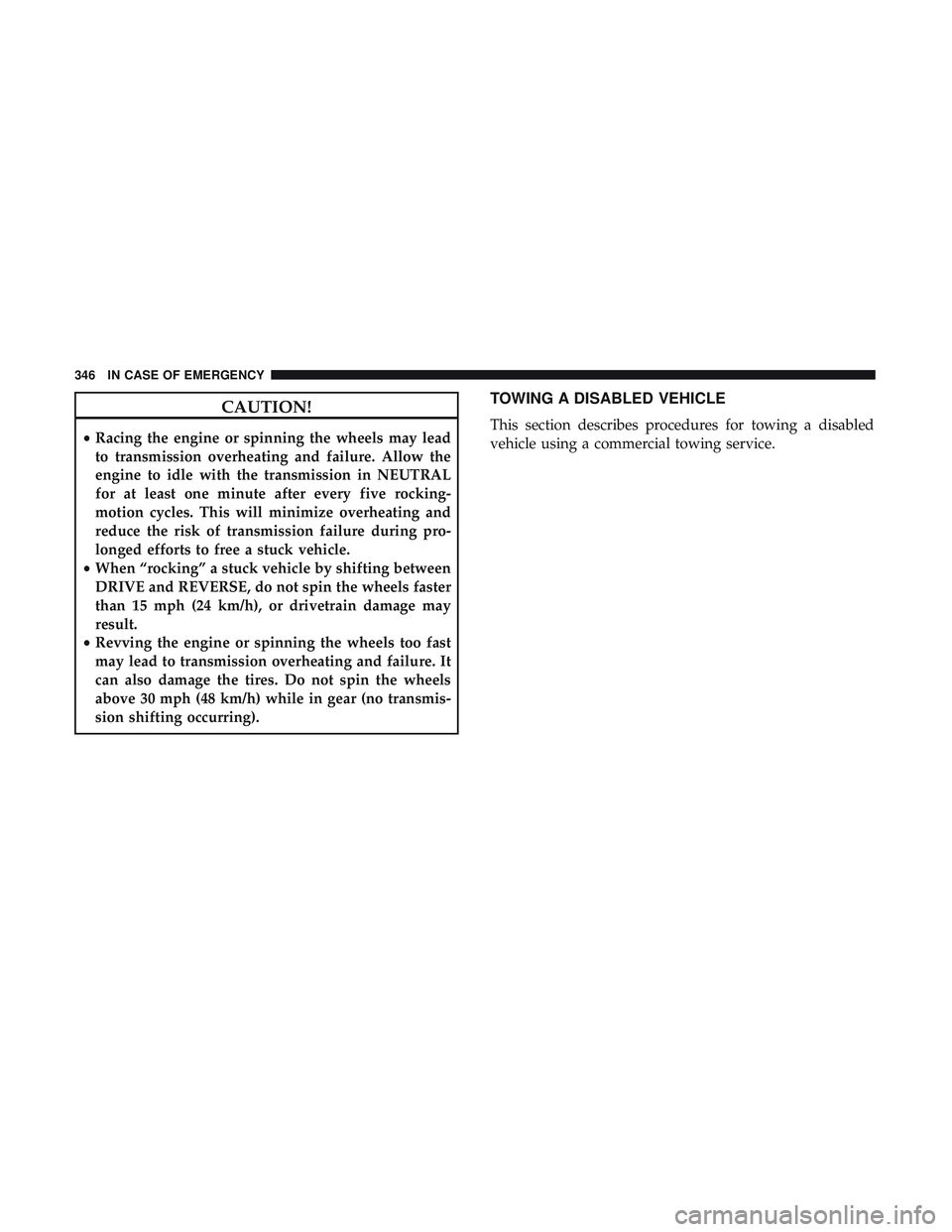
CAUTION!
•Racing the engine or spinning the wheels may lead
to transmission overheating and failure. Allow the
engine to idle with the transmission in NEUTRAL
for at least one minute after every five rocking-
motion cycles. This will minimize overheating and
reduce the risk of transmission failure during pro-
longed efforts to free a stuck vehicle.
• When “rocking” a stuck vehicle by shifting between
DRIVE and REVERSE, do not spin the wheels faster
than 15 mph (24 km/h), or drivetrain damage may
result.
• Revving the engine or spinning the wheels too fast
may lead to transmission overheating and failure. It
can also damage the tires. Do not spin the wheels
above 30 mph (48 km/h) while in gear (no transmis-
sion shifting occurring).
TOWING A DISABLED VEHICLE
This section describes procedures for towing a disabled
vehicle using a commercial towing service.
346 IN CASE OF EMERGENCY
Page 382 of 553
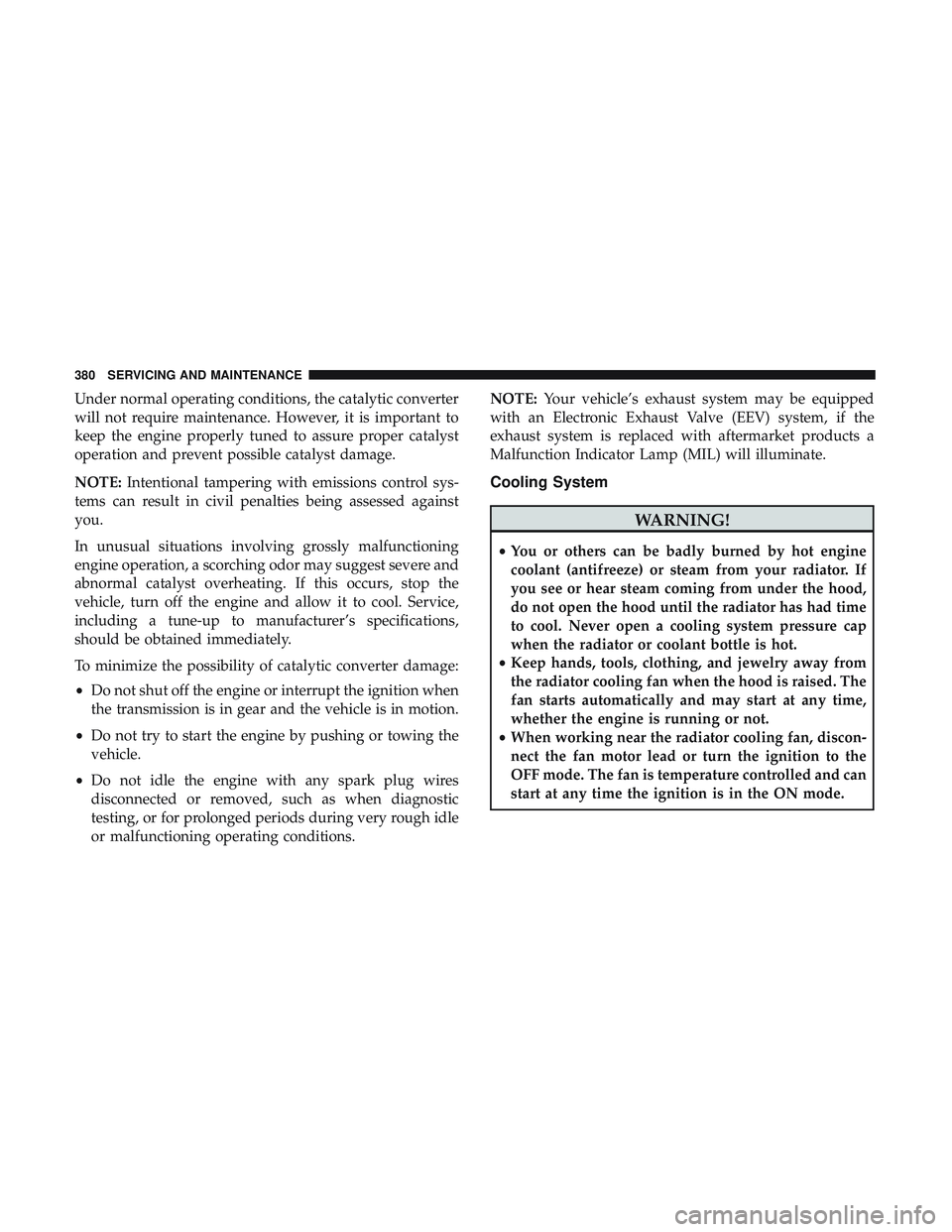
Under normal operating conditions, the catalytic converter
will not require maintenance. However, it is important to
keep the engine properly tuned to assure proper catalyst
operation and prevent possible catalyst damage.
NOTE:Intentional tampering with emissions control sys-
tems can result in civil penalties being assessed against
you.
In unusual situations involving grossly malfunctioning
engine operation, a scorching odor may suggest severe and
abnormal catalyst overheating. If this occurs, stop the
vehicle, turn off the engine and allow it to cool. Service,
including a tune-up to manufacturer’s specifications,
should be obtained immediately.
To minimize the possibility of catalytic converter damage:
• Do not shut off the engine or interrupt the ignition when
the transmission is in gear and the vehicle is in motion.
• Do not try to start the engine by pushing or towing the
vehicle.
• Do not idle the engine with any spark plug wires
disconnected or removed, such as when diagnostic
testing, or for prolonged periods during very rough idle
or malfunctioning operating conditions. NOTE:
Your vehicle’s exhaust system may be equipped
with an Electronic Exhaust Valve (EEV) system, if the
exhaust system is replaced with aftermarket products a
Malfunction Indicator Lamp (MIL) will illuminate.
Cooling System
WARNING!
• You or others can be badly burned by hot engine
coolant (antifreeze) or steam from your radiator. If
you see or hear steam coming from under the hood,
do not open the hood until the radiator has had time
to cool. Never open a cooling system pressure cap
when the radiator or coolant bottle is hot.
• Keep hands, tools, clothing, and jewelry away from
the radiator cooling fan when the hood is raised. The
fan starts automatically and may start at any time,
whether the engine is running or not.
• When working near the radiator cooling fan, discon-
nect the fan motor lead or turn the ignition to the
OFF mode. The fan is temperature controlled and can
start at any time the ignition is in the ON mode.
380 SERVICING AND MAINTENANCE
Page 401 of 553
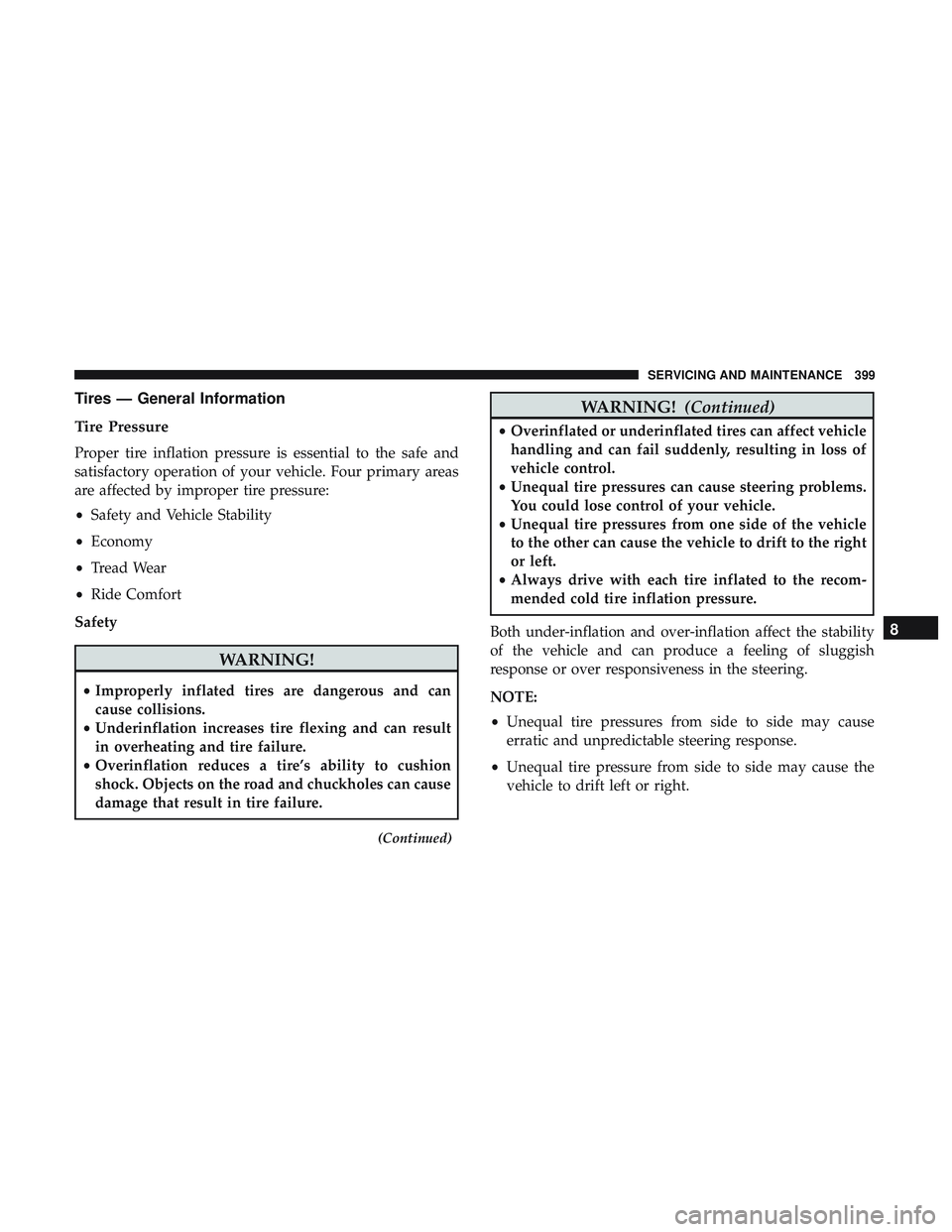
Tires — General Information
Tire Pressure
Proper tire inflation pressure is essential to the safe and
satisfactory operation of your vehicle. Four primary areas
are affected by improper tire pressure:
•Safety and Vehicle Stability
• Economy
• Tread Wear
• Ride Comfort
Safety
WARNING!
• Improperly inflated tires are dangerous and can
cause collisions.
• Underinflation increases tire flexing and can result
in overheating and tire failure.
• Overinflation reduces a tire’s ability to cushion
shock. Objects on the road and chuckholes can cause
damage that result in tire failure.
(Continued)
WARNING! (Continued)
•Overinflated or underinflated tires can affect vehicle
handling and can fail suddenly, resulting in loss of
vehicle control.
• Unequal tire pressures can cause steering problems.
You could lose control of your vehicle.
• Unequal tire pressures from one side of the vehicle
to the other can cause the vehicle to drift to the right
or left.
• Always drive with each tire inflated to the recom-
mended cold tire inflation pressure.
Both under-inflation and over-inflation affect the stability
of the vehicle and can produce a feeling of sluggish
response or over responsiveness in the steering.
NOTE:
• Unequal tire pressures from side to side may cause
erratic and unpredictable steering response.
• Unequal tire pressure from side to side may cause the
vehicle to drift left or right.
8
SERVICING AND MAINTENANCE 399
Page 540 of 553
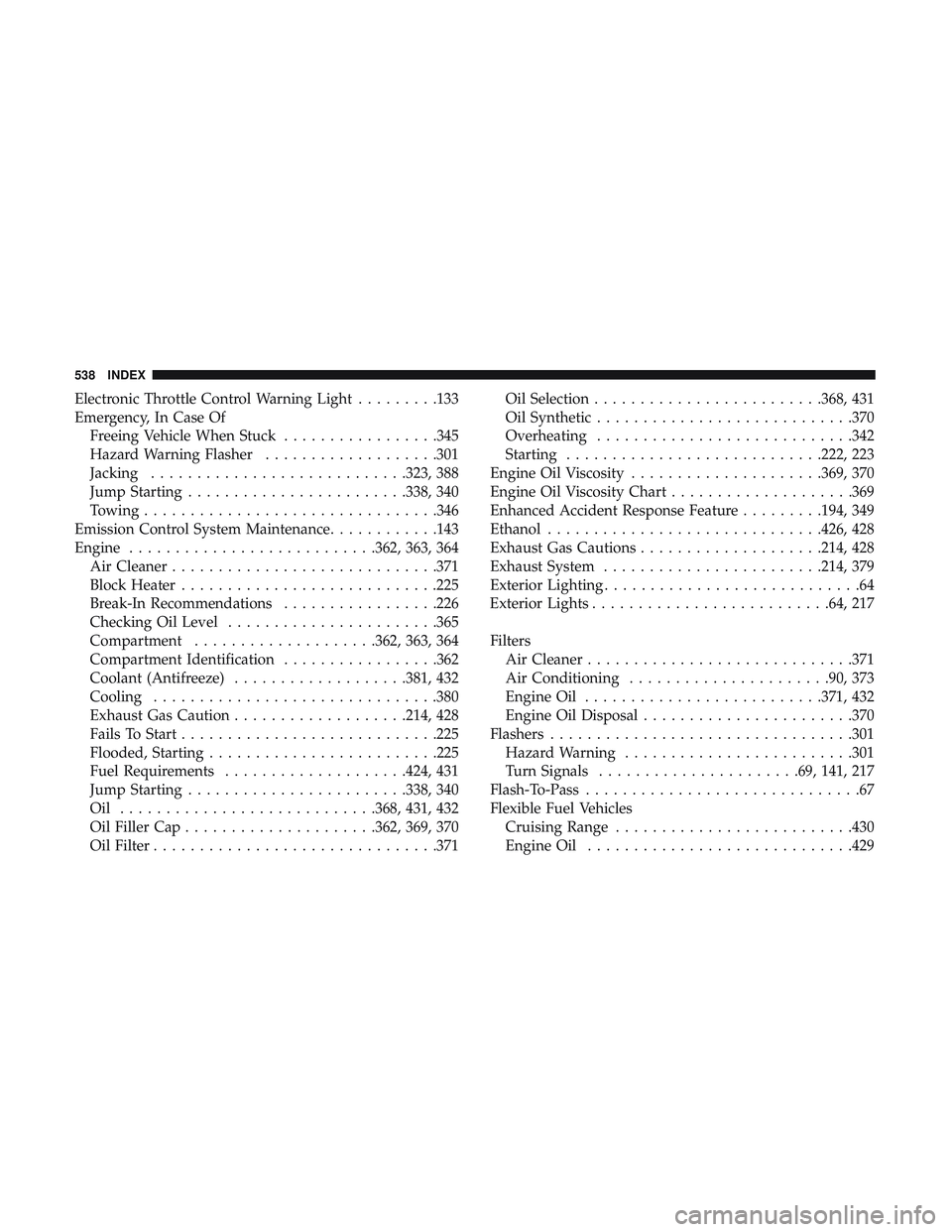
Electronic Throttle Control Warning Light.........133
Emergency, In Case Of Freeing Vehicle When Stuck .................345
Hazard Warning Flasher ...................301
Jacking ............................323, 388
Jump Starting ........................338, 340
Towing ............................... .346
Emission Control System Maintenance ............143
Engine .......................... .362, 363, 364
Air Cleaner ............................ .371
Block Heater ............................225
Break-In Recommendations .................226
Checking Oil Level .......................365
Compartment ....................362, 363, 364
Compartment Identification .................362
Coolant (Antifreeze) ...................381, 432
Cooling ...............................380
Exhaust Gas Caution ...................214, 428
Fails To Start ............................225
Flooded, Starting ........................ .225
Fuel Requirements ....................424, 431
Jump Starting ........................338, 340
Oil ............................368, 431, 432
Oil Filler Cap .....................362, 369, 370
Oil Filter ...............................371 Oil Selection
........................ .368, 431
Oil Synthetic ............................370
Overheating ............................342
Starting ............................222, 223
Engine Oil Viscosity .....................369, 370
Engine Oil Viscosity Chart ....................369
Enhanced Accident Response Feature .........194, 349
Ethanol ............................. .426, 428
Exhaust Gas Cautions ....................214, 428
Exhaust System ........................214, 379
Exterior Lighting............................
64
Exterior Lights ..........................64, 217
Filters Air Cleaner ............................ .371
Air Conditioning ..................... .90, 373
Engine Oil ..........................371, 432
Engine Oil Disposal .......................370
Flashers .................................301
Hazard Warning ........................ .301
Turn Signals ..................... .69, 141, 217
Flash-To-Pass ..............................67
Flexible Fuel Vehicles Cruising Range ..........................430
Engine Oil ............................ .429
538 INDEX
Page 545 of 553
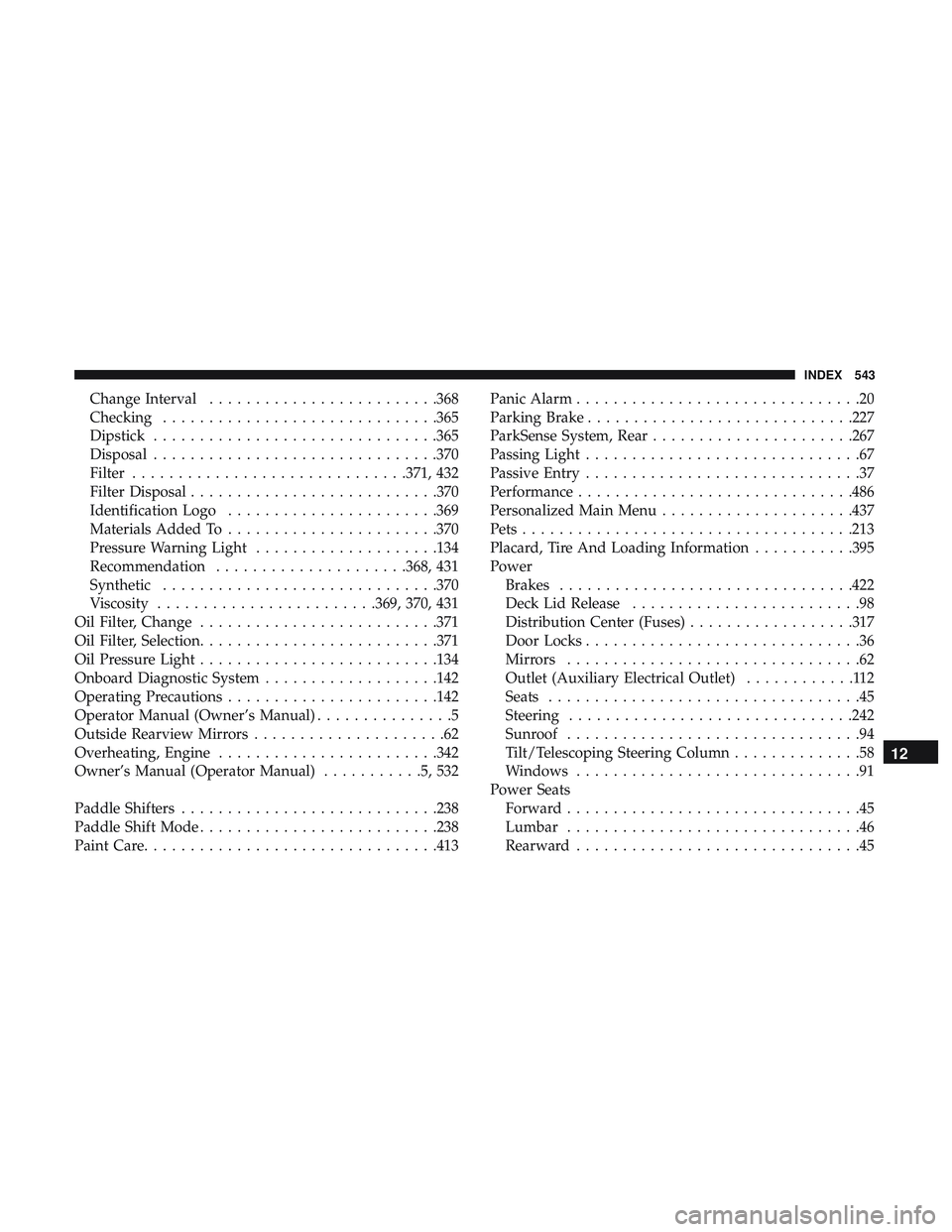
Change Interval........................ .368
Checking ............................. .365
Dipstick ...............................365
Disposal ...............................370
Filter ............................. .371, 432
Filter Disposal .......................... .370
Identification Logo .......................369
Materials Added To .......................370
Pressure Warning Light ....................134
Recommendation .....................368, 431
Synthetic ............................. .370
Viscosity ........................369, 370, 431
Oil Filter, Change ..........................371
Oil Filter, Selection ..........................371
Oil Pressure Light ..........................134
Onboard Diagnostic System ...................142
Operating Precautions .......................142
Operator Manual (Owner’s Manual) ...............5
Outside Rearview Mirrors .....................62
Overheating, Engine ........................342
Owner’s Manual (Operator Manual) ...........5,532
Paddle Shifters ............................238
Paddle Shift Mode ..........................238
Paint Care ............................... .413Panic Alarm
...............................20
Parking Brake ............................ .227
ParkSense System, Rear ..................... .267
Passing Light ..............................67
Passive Entry ..............................37
Performance ............................. .486
Personalized Main Menu .....................437
Pets ................................... .213
Placard, Tire And Loading Information ...........395
Power Brakes ............................... .422
Deck Lid Release .........................98
Distribution Center (Fuses) ..................317
Door Locks ..............................
36
Mirrors ................................62
Outlet (Auxiliary Electrical Outlet) ............112
Seats ..................................45
Steering ...............................242
Sunroof ................................94
Tilt/Telescoping Steering Column ..............58
Windows ...............................91
Power Seats Forward ................................45
Lumbar ................................46
Rearward ...............................45
12
INDEX 543